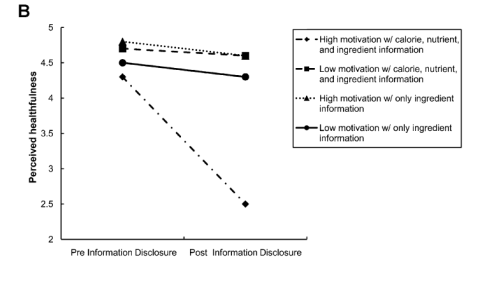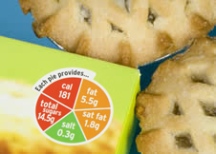Food selection and consumption is a complex phenomenon, influenced by sensory and non-sensory food characteristics and also by labeling, which plays an important role in consumer responses, influencing the expectations and perceptions of the product (Chiou, Yeh, & Chang, 2009; Shepherd, Sparks, & Raats, 1991). Hence, current provision of disclosure food’s nutrition information is one of the most critical elements in foods packaging. Some foods even highlight such kind of information to make it different from others so as to win the consumers. Will these information influence consumers purchasing decision and what’s their response to the nutrition disclosure?
To begin with, I will briefly talk about the reasons attributing to the nutrition reveal. Nowadays, obesity and health is considered as of great importance among consumers. Therefore, when purchasing food to some extent they will estimate the nutrition amount contained in the food, such as calories, protein and etc. However, research made by the New York Times showed that people generally have difficulty in estimating such nutrition amounts due to the fact that consumers feel surprised by the calorie content of menu items such as some salads and chicken sandwiches, which at times are much less healthful than consumers expect (Tangari, 2010). From early studies, it is proved that consumers tend to: “(1) underestimate calories more for unhealthful meals than healthful meals; (2) overestimate calories in very low-calorie meals. (3) Accuracy of consumers’ calorie estimates will differ across restaurants. Consumers will underestimate calories more for meals from restaurants where their perceptions of healthfulness are less accurate, relative to meals at restaurant where consumers have more accurate perceptions of the healthfulness” (Tangari et al, 2010). According to what mentioned above, providing calorie information appears to be especially important for food and restaurants about which consumers may have a misperception of the healthfulness of the meals in general, as well as for very high-calorie meals.
Such bias in estimating calories and nutrition is able to influence consumers purchasing decisions. If you overestimated the amount, consumers are more likely to be positively motivated to purchase the food. While if you underestimate the amount, the purchasing desire will be decreased. Whereas, when it comes to the post- episode consumption, the results of MANOVA indicate that the provision of nutrition information that is contrary to prior expectations can have a significant influence on subsequent food consumption. After consumers have been presented with information that implies the food previously consumed was higher in calories, fat, and saturated fat than expected, fewer calories were consumed in subsequent consumption episodes. The chart below can more intuitively interpret it (Howlett et al, 2012).
Nevertheless, consumers have different expectations for different products so that not all nutrition disclosures showing healthier consumption will result in an affirmative effect. Taking biscuit for example, consumers’ aim to buy such stuff is to enjoy their afternoon tea or to satisfy a carving for good foods so the taste is the most important factor. Additionally, less calories, more nutrition elements to some degree lay a negative impression on consumers due to the fact that healthier food mostly scarifies its good taste (Carrillo et al, 2012). Therefore, the striking nutrition disclosure of hedonistic-oriented products is possible to hinder consumers’ purchasing decision.
Then, how can such nutrition disclosure be more beneficial? I concludes two tips.
(1) Mohr and others (2012) proposed that “marketers should consider reducing serving sizes (health framing), especially in product categories or segments in which consumers are calorie conscious.” When conducting promotion, marketers should emphasize more on the nutrition amount and avoid mentioning the weight of a serving.
(2) When packaging and displaying nutrition information, sellers avoid significant disclosure for hedonistic-oriented foods and emphasis more of nutrition amount for foods related to health since consumers do not want to scarifies the taste on such foods.




This is a really interesting blog! Labels on food can make a huge difference on the purchasing behaviour of consumers. Thomdike et al. (2012) discovered that just putting red labels on beverages decreased the sale of them by 16.5%. This does not sound like a big percentage but the cafeteria Thomdike et al used this intervention on had 6534 purchases a day. Furthermore, Thomdike et al placed green labels on other beverages and found that this increased sales by 9.6%.
Companies could easily alter the nutritional labels on foods by changing their colour. This simple colour change could change their sales dramatically!
Great blog!
In this country, there’s actually no set guidelines on what the information presented on packaging should actually contain or look like. This can lead to very misleading statistics, such as when a drink gives it’s GDA per 125ml for a 500ml bottle, making it look like there’s less sugar (for example) than there actually is.
It also can be misleading from a health point of view. Just because
a product claims to contain 1 of your 5 a day, doesn’t mean it’s healthy, since it could contain well above your daily amount of salt intake.
Many consumers have stated they prefer a traffic light system (http://www.bbc.co.uk/news/health-20050420) when it comes to glancing at food packaging. Hopefully these new guidelines should be out next year.
In terms of why companies have clearly laid out these facts on their packages in my opinion is because, what involved in making these products, especially food, signifies how consumers perceive the company? For e.g. if any particular food industry would like to endorse itself with being healthy and sustainable, then these nutrition facts might be labeled and advertised with healthy ingredients, so that consumers will perceive this particular company with being healthy.
In the other hand, identity is the subjective concept of how an individual views themselves (Vignoles, Regalia, Manzi, Golledge & Scabini, 2006). Consumers might want to be perceived as a healthy eater, thus, these labels indicates how much calories should they consume per day. As mentioned in one of our consumer lecture, Dr James mentioned about brand is our mental representation(s) which consist of accumulations of experiences in any forms, and by indicating clearly with these nutrition facts, consumers may perceive the company as trustworthy, user friendly, therefore may trigger future repurchases.
Good blog. This topic is really important because everyone is involved. I asked myself several times why some people buy ‘low calories’ food. If we read the description of nonsense that is added in most products of this type, we’ll understand how actually unhealthy it is. Not only because of the sweeteners added, but also because of apparent lightness, people tend to eat more of those ‘low calories’ items. As a result they get more calories, than in case they eat ordinary food. Although many people are aware of the zero effectiveness of such stuff, they continue believing in the myth that it might help them to maintain slender figures or loose weight.
Pingback: Remove the confusion? Annex 13 GMP Guide – Webinar by Baidu | MyInfoWiZARD.COM